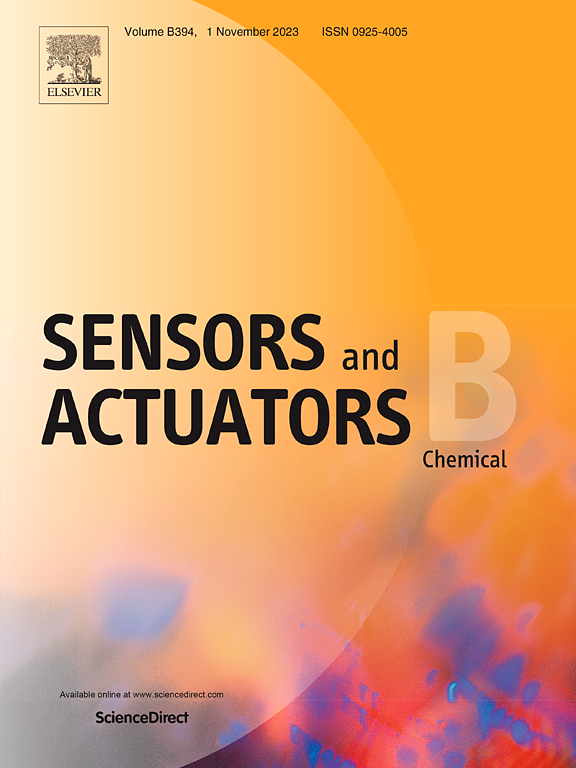限制性酶探针增强的PER-Cas12a化学发光生物传感器用于血清中可溶性PD-L1的超灵敏检测
IF 8
1区 化学
Q1 CHEMISTRY, ANALYTICAL
引用次数: 0
摘要
循环可溶性程序性死亡配体1(循环可溶性程序性死亡配体1,sPD-L1)是一种重要的免疫调节分子,在肿瘤早期诊断、指导免疫治疗和监测预后方面具有重要价值。在这项研究中,我们开发了一种超灵敏和可编程的限制性酶探针增强的PER-Cas12a化学发光(CEP-EPC)平台,用于检测sPD-L1。该系统通过适配体靶向识别sPD-L1和级联引物交换反应(PER)启动Cas12a的反式切割活性。然后,激活的Cas12a在受限酶探针上循环切割单链DNA (ssDNA),导致释放酶标记的ssDNA。磁分离后,均相溶液中HRP的存在显著放大了鲁米诺-过氧化氢(H2O2)体系中的化学发光信号。该传感器的线性范围为5 ~ 5 × 103 pg/mL,检测限低至1.02 pg/mL。利用6个细胞系和112个临床测试样本验证了该传感器的分析性能。受试者工作特征(ROC)曲线分析表明,该策略可有效区分肿瘤患者与健康供体:非小细胞肺癌(NSCLC, AUC = 0.8750)、胃癌(AUC = 0.9325)、胰腺癌(AUC = 0.9725)、乳腺癌(AUC = 0.8500)。值得注意的是,显著正相关(r = 0.6444, p <;在一组12例非小细胞肺癌患者中,组织PD-L1表达与血清sPD-L1水平之间的差异为0.0500),提示该策略在指导PD-1/PD-L1免疫检查点阻断治疗中的潜在应用。总的来说,这些发现使CEP-EPC平台成为精确肿瘤学的一个强大而有前途的工具。本文章由计算机程序翻译,如有差异,请以英文原文为准。
Confined Enzyme Probe-Enhanced PER-Cas12a Chemiluminescence Biosensor for Ultrasensitive Detection of Soluble PD-L1 in Serum
Circulating soluble programmed death ligand 1 (sPD-L1), a critical immunomodulatory molecule, holds significant value for early tumor diagnosis, directing immunotherapy, and monitoring prognosis. In this study, we developed an ultra-sensitive and programmable confined enzyme probe-enhanced PER-Cas12a chemiluminescence (CEP-EPC) platform for detecting sPD-L1. This system initiates the trans-cleavage activity of Cas12a via aptamer-targeted recognition of sPD-L1 and a cascade primer exchange reaction (PER). Then, the activated Cas12a cyclically cleaves single-stranded DNA (ssDNA) on the confined enzyme probe, resulting in the release of HRP-labeled ssDNA. Following magnetic separation, the presence of HRP in the homogeneous solution markedly amplifies the chemiluminescence signal in the luminol-hydrogen peroxide (H2O2) system. The constructed sensor exhibits a linear range from 5 to 5 × 103 pg/mL, with a detection limit as low as 1.02 pg/mL. The analytical performance of the developed sensor was validated using 6 cell lines and 112 clinical test samples. Receiver operating characteristic (ROC) curve analysis demonstrated that the strategy could effectively distinguish tumor patients from healthy donors: non-small cell lung cancer (NSCLC, AUC = 0.8750), gastric cancer (AUC = 0.9325), pancreatic cancer (AUC = 0.9725), and breast cancer (AUC = 0.8500). Notably, a significant positive correlation (r = 0.6444, p < 0.0500) was observed between tissue PD-L1 expression and serum sPD-L1 levels in a cohort of 12 NSCLC patients, suggesting the potential application of this strategy in guiding PD-1/PD-L1 immune checkpoint blockade therapies. Collectively, these findings establish the CEP-EPC platform as a robust and promising tool for precision oncology.
求助全文
通过发布文献求助,成功后即可免费获取论文全文。
去求助
来源期刊

Sensors and Actuators B: Chemical
工程技术-电化学
CiteScore
14.60
自引率
11.90%
发文量
1776
审稿时长
3.2 months
期刊介绍:
Sensors & Actuators, B: Chemical is an international journal focused on the research and development of chemical transducers. It covers chemical sensors and biosensors, chemical actuators, and analytical microsystems. The journal is interdisciplinary, aiming to publish original works showcasing substantial advancements beyond the current state of the art in these fields, with practical applicability to solving meaningful analytical problems. Review articles are accepted by invitation from an Editor of the journal.
 求助内容:
求助内容: 应助结果提醒方式:
应助结果提醒方式:


